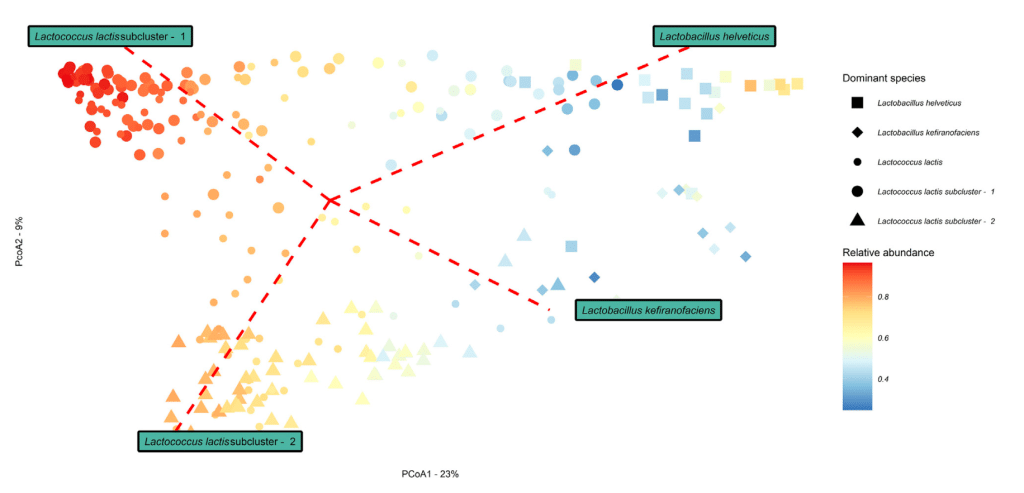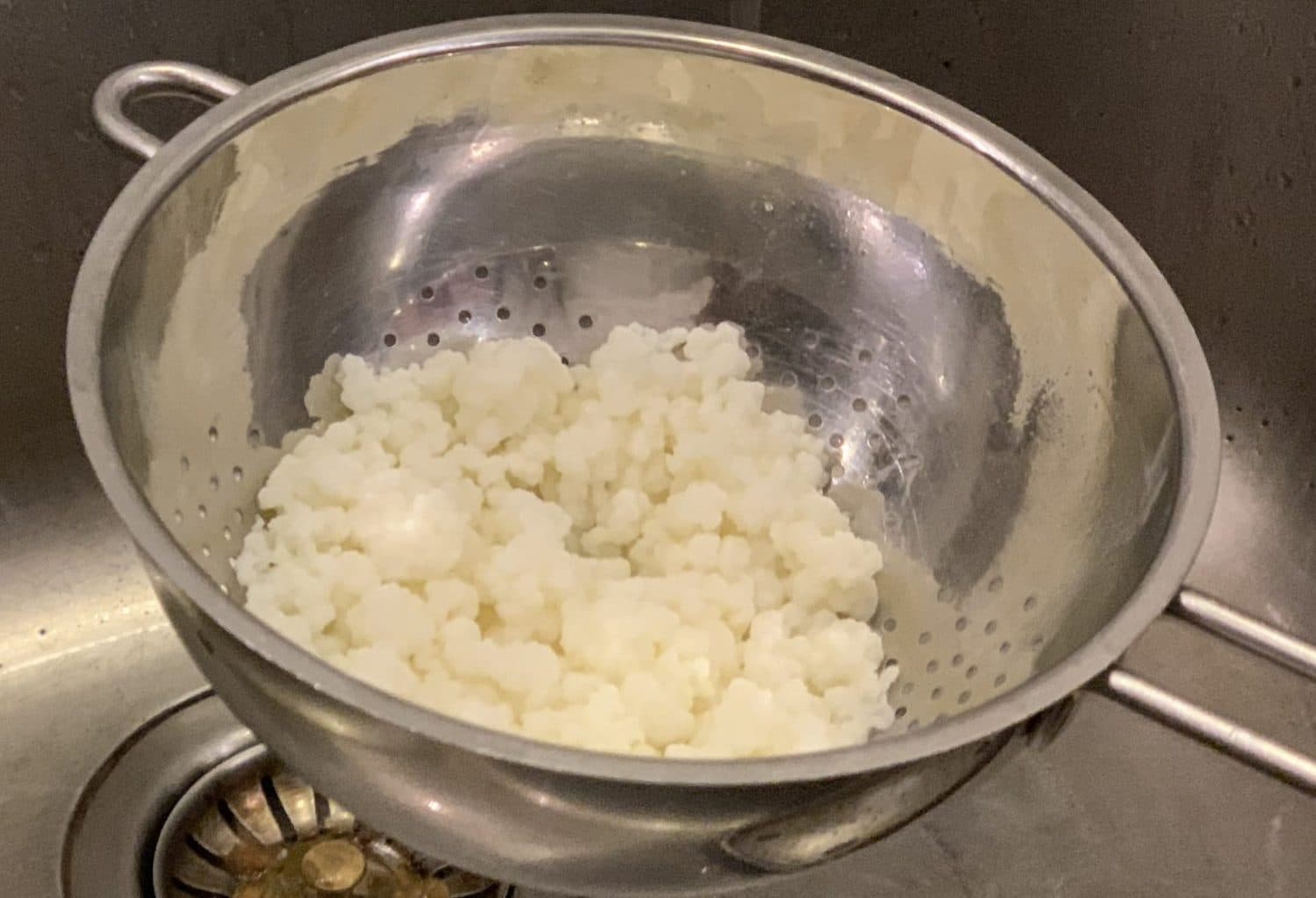Take home message
- Kefir originates from grains, but can nevertheless vary considerably in terms of the composition of micro-organisms.
- What makes kefir kefir is the presence of lactose fermenting bacteria in a multitude of bacterial strains, supplemented by small amounts of yeasts and moulds. Lactococcus lactis dominates.
Kefir grains (= kefir plant = SCOBY) can be found all over the world, but are there any differences? The dairy industry has discovered kefir in the past 10 years and you can buy kefir everywhere in the supermarket. The word kefir is not protected, and you notice this when you look at the species composition of kefir.
Irish researchers (Walsh et al., 2023) wanted to know if there is some kind of pan-genome of all these grains, which is another question for ‘what makes kefir kefir’? Is there something overarching in the composition (or functionality) of kefirs? From many parts of the world, 64 different grains were collected. In pasteurised, whole cow’s milk, kefir was then made from all grains in the same way. It was examined whether the kefir differed in composition.
Kefir genome and kefir functionality
A total of 46 different species of bacteria and fungi were found in all kefirs. The kefir drinks made from the 64 kefir grains from 25 countries can be reduced to four main groups (clusters). The regional origin of the grains does not coincide with this cluster classification. Four bacterial species differntiate all kefirs, but occur in different concentrations. As a result, ‘world kefir’ breaks down into four subgroups (Fig 1). Kefir consists mainly of lactic acid bacteria, mostly Lactococcus lactis strains, sometimes cremoris strains of Lactococcus lactis. In cluster-1 L.lactis ssp lactis dominates, in cluster-2 L.lactis ssp cremoris. Both lactic acid bacteria species belong to the core microbiome of kefir drinks. To a lesser extent, other species dominated, such as Lactobacillus kefiranofaciens, a typical bacterium dominant in the grains themselves or also L.helveticus. Kefir is thus mainly characterised by a bacterial soup, but yeasts and fungi such as Saccharomyces and Kluyveromyces-species are also part of kefir, however in low concentrations (see Table 1).

Fig. 1. Based on cluster analysis, four groups emerge in which a particular species is dominant. These are differences in dominance; all species together make up the core of typical kefir bacteria (taken from Walsh et al., 2023).
Differences in composition among the all kefir samples analysed are large (Table 1). The common lactic acid bacterium Lactococcus lactis is on average the most dominant bacterial species (63.9%), however there is a huge spread (from 0.3 to 96.5%), followed at a great distance by Lactobacillus helveticus (8.2%). The typical bacterium Lactobacillus kefiranofaciens, which is responsible for building the skeleton of the grains is also present in kefir drinks at 5.2%. Fungi and yeasts are a very small part of the kefir composition. The species all occur below 0.5%, but again, there can be big differences between kefir origins. A total of 46 species of bacteria, yeasts and fungi were found. The number of strains is many times higher still.
Table 1. Mean, minimum and maximum distribution (%) of bacterial species and yeasts/fungi of kefir made from grains from around the world (derived from Walsh et al., 2023). (Bacterial species below 1% not shown. All fungi are included).
| Species | Mean | Min | Max |
| Bacteria | % | % | % |
| Lactococcus lactis | 63.9 | 0.3 | 96.5 |
| Lactobacillus helveticus | 8.2 | 0.0 | 77.0 |
| Lactobacillus kefiranofaciens | 5.2 | 0.0 | 57.6 |
| Lactococcus garvieae | 2.0 | 0.0 | 8.9 |
| Leuconostoc mesenteroides | 1.9 | 0.0 | 84.6 |
| Pseudomonas helleri | 1.8 | 0.0 | 60.1 |
| Acetobacter fabarum | 1.6 | 0.0 | 29.0 |
| Streptococcus thermophilus | 1.0 | 0.0 | 31.2 |
| Acetobacter cibinongensis | 1.0 | 0.0 | 13.5 |
| Lentilactobacillus kefiri | 1.0 | 0.0 | 24.7 |
| Fungi | |||
| Bacillus licheniformis | 0.2 | 0.0 | 1.9 |
| Saccharomyces cerevisiae | 0.1 | 0.0 | 6.0 |
| Kluyveromyces marxianus | 0.1 | 0.0 | 4.9 |
| Bacillus mycoides | 0.1 | 0.0 | 14.9 |
| Saccharomyces eubayanus | 0.0 | 0.0 | 1.1 |
Strains ultimately determine genetic differences in functionality. Lactic acid bacteria not only produce lactic acid from lactose, but are also responsible for numerous other metabolic products including the bioactive peptides from protein breakdown, and which we also know by the term of postbiotics. Metabolism can vary from strain to strain. There are differences between clusters, for example, which fatty acids are produced or how much vitamin K2 is produced.
With help of this metagenomic research approach, we can now also understand the breakdown and build-up chain of certain substances. The core microbiome of each kefir unites more than 50 such breakdown and build-up processes typical of each kefir drink. What is clear in terms of action, among other things, is that there is an impact of kefir on blood pressure, or on immunology. However, because of the differences in origin of the grains, there are also substances that belong to specific species or strains present or not. Over 200 other metabolic products have been detected that distinguish one kefir from another in smell, taste or impact. So not every kefir (from grains) will give exactly the same result; it all depends on the total package of bacterial species, strains, yeasts and moulds present in the grains.
Kefir in The Nederlands
Besides kefir from grains, kefir is of course also made on a large scale, using a selection of bacteria and fungi: so-called freeze-dried starter cultures. Comparative research on the composition of bacteria and fungi shows differences between some organic kefir offered on the Dutch market (Table 2). All kefir varieties contain bacteria and yeasts. In terms of bacteria, Lactococcus lactis(strains) are present everywhere (logically), whether or not together with Streptococcus thermophilus. In terms of fungi, the differences are greater. Thereby, you can assume, that what can be found in the starter culture (freeze-dried or not) also shows up in the final product. The beer or baker’s yeast Saccharomyces cervisiae is found in pasteurised kefirs, or also Debaromyces. Debaromyces is with high probability Debaromyces hansenii, one of the many fungi, described from the 1920s onwards, used in starter cultures for fermented dairy products worldwide.
Raw milk kefir made from a commercial starter (no. 4) in this case contains Debaromyces, while the kefir made from backslopped grains (no. 5) contains another, much richer pallet of typical fungi found in traditional kefir worldwide. These are species from the genus Galactomyces, Kazachstania and Kluyveromyces.
Table 2. Three bio-kefir varieties from pasteurised milk (Nos 1-3) compared to two from raw milk (Nos 4-5); SC = starter culture, grains = SCOBY-based; the relative distribution (%) of bacteria and yeasts/fungi (fungi). (Source: own data)
| From pasteurised milk | From raw milk | ||||
| SC | SC | SC | SC | grains | |
| Bacteria | (1) | (2) | (3) | (4) | (5) |
| Lactococcus lactis | 84.6 | 74.5 | 52.2 | 74.9 | 99.7 |
| Streptococcus thermophilus | 24.2 | 27.5 | 24.2 | ||
| Lactococcus | 12.7 | 0.2 | 19.2 | ||
| Leuconostoc | 2.7 | 1.0 | 1.1 | 0.8 | 0.1 |
| Fungi | |||||
| Saccharomyces cerevisiae | 96.7 | 98.2 | 16.6 | ||
| Debaryomyces | 2.1 | 0.3 | 83.3 | 84.9 | |
| Pichia kudriavzevii | 11.9 | ||||
| Galactomyces | 2.4 | 63.2 | |||
| Kazachstania unispora | 0.9 | 19.8 | |||
| Kazachstania turicensis | 9.3 | ||||
| Kluyveromyces marxianus | 7.7 | ||||
Tables 1 and 2 are not fully comparable. Table 1 shows the absolute ratio of all species to each other, while in Table 2 the bacteria and fungi are presented separately. Even for the kefirs in Table 2, the absolute amount of moulds and yeasts is small.
Ripening, fermentation or spoilers?
Yeasts and moulds of the genera Debaromyces, Candida, Galactomyces, Kluyveromyces or Saccharomyces are usually seen as organisms that cause the ‘spoilage’ of a food. There are differences in alcohol formation and the degree of sparkling due to carbonation. The line between degradation, flavour and odour formation, conversion and spoilage is not always sharp. After lactic acid formation (milk sugar into lactic acid) come the yeasts, which (among other things) break down lactic acid further and provide flavour and aroma, as well as ‘by-products’ that have their effect on our health. You might not want to find them in pre-packaged cheese or on your fruit bowl, but in kefir, yeasts and moulds are important, desirable species.
Literature
- Walsh, L. H., Coakley, M., Walsh, A. M., Crispie, F., O’Toole, P. W., & Cotter, P. D. (2023). Analysis of the milk kefir pan-metagenome reveals four community types, core species, and associated metabolic pathways. Iscience, 26(10).




